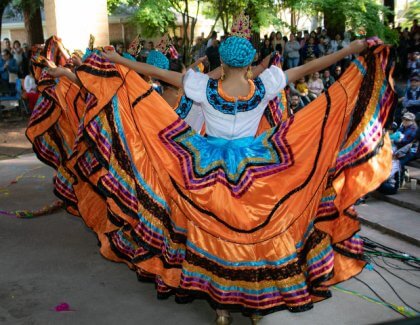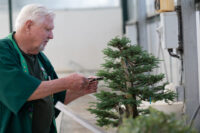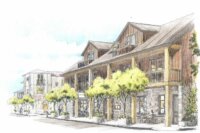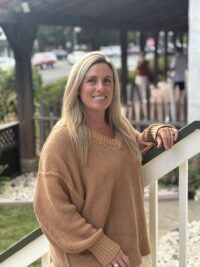The work of Noemí Vázquez has been displayed recently by folkloric dancers at various celebrations of Mexican Independence Day, during Hispanic Heritage month. The Sun’s Anna Pier sat down to speak in Spanish with the talented seamstress for Quetzalén, our local folkloric dance troupe and school.
How did you begin to sew for Quetzalén?
In 2008 my three granddaughters were learning folkloric dance with the group and I made them practice skirts. When Maestro Juan, the director at that time. saw those big, full beautiful skirts, he asked me if I would make them for all the students. “Sí, como no. Of course,” I told him. They could only pay me $12/skirt, but I did it to help support the ballet. In 2013 he asked me to make a dance costume for the performances.

Which one did you start with?
It was the beautiful Jalisco de Gala. It’s the formal dance costume of that state. In rich orange with turquoise. So much satin fabric – ten yards in one skirt. It was very complicated, with different shapes, lots of ribbon decoration, and a star-shaped insert of blue fabric at the waist. I made up one dress, and Maestro Juan loved it, so he asked for 24 more. There was another big challenge too – how to make it so it would fit different bodies, slim and full. I finally figured that out too. I felt such satisfaction, so much pride when I saw the dancers. To see my work in motion! Then they wanted another 25 for the young dancers!
Did you have a pattern?
I’m what we call “lírica,” which means I’m self-taught, I’ve learned my trade without any formal study. I do everything by looking and thinking. I almost never use a pattern. My mother sewed, and I learned in part from watching her. I made my own wedding dress.
What’s your method?
Víctor Ferrer, the teacher and director, gives me a picture of the dress for the new regional dance they are learning, and the fabric. I think about it, then I make one. One of the dancers wears it at a practice.When Víctor gives the green light, I take measurements of the dancers, and start in on the order. Sometimes 12, sometimes 15, or 25 dresses. If there are separate parts, like a flounce that gets sewn onto the skirt, I make all of those at once. I have a river of flounces!
Do you baste the pieces?
No basting, no preliminary stitching. I cut, use my logic, and then go straight to the machine.
How long does it take you to make one complete dance costume?
I would guess around four hours. I’m really quick at finishing a project! Very quick but very careful. I don’t look back at my work; I know what I’ve done is good, well-done. I’ve never had a complaint. And I always do all my own work.
How many different dance costumes have you made for Quetzalén?
So many. I’ve made all the practice skirts and blouses, fifty or sixty of those. The most recent I’ve made are 12 for the Fandango, from the State of Veracruz, and 14 from the State of Tabasco, using the same red and blue print fabric, but a different style. And 20 of the beautiful flowered dresses with a ruffled bodice from Baja California Sur. And 12 of the three-part dress from my home state of Sinaloa. And the classic traditional dance costume of Jalisco for girls.
Dresses only?
No, I made the long robes adorned with feathers and the elaborate tall hats for the dance from the State of Morelos, Los Chinelos. And other costumes for boys and men. And I designed and made containers for their big classic sombreros.
Where did you grow up?
In Mazatlán, Sinaloa. After high school, I took a secretarial course, and ended up working for eight years at the Nautical School in Mazatlán, where people trained as naval engineers and captains. That’s where I met my husband. He was a naval engineer. We lived in Manzanillo, Colima for 16 years. When we were going through a bad period, I decided to go to my mother and sister in Sonoma.
How did you get to the U.S.?
Very comfortably, on a plane, with a visa. I and my four children, 15,13,11 and 4. I didn’t plan to stay, but I ended up working at a factory in Glen Ellen where my sister worked, making nets. I was there for eight years, till it closed in ’96. My children were really attached to this community, so I stayed.

And then?
Different jobs. I worked at McDonald’s. Then after taking a course in cosmetology, I worked in a beauty salon for several years till it closed. I’d been casting about until I met the ballet. And I also have other clients, I make things to order. I’m always making something – lined bags with interior pockets, totes from coffee bean bags. Right now on weekdays I take care of my son’s two small children and I always bring my sewing machine with me.
Do you make everything on the little Singer?
With a $1,000 micro-loan, I got a $1,200 industrial machine. At the same time I was paying the loan off, the motor burned out and I had to buy a new one. Twice. But now I use both machines.
As a girl, a young woman, what did you dream of ?
To be a designer, creating my own designs and fabricating them. It didn’t work out. But I’ve realized this dream little by little. Creating the dance costumes. When I see my creations in motion, with so many people dancing, I am filled with pleasure. I fall in love with my work. And I wonder, “When did I get it all done?”
Any final thoughts about your work?
I am very proud to be a part of the work of Quetzalén. Our Mexican culture is reflected so much in the folklore traditions of each state. It’s marvelous that Víctor Ferrer is here for us, continuing to present the culture of Mexico. It’s very important for the Mexican community to feel our culture appreciated by the whole community.
Video of Noemí at work on dress of Baja California Sur; and dress from her native Sinaloa.










I have enjoyed many of these beautiful dances and costumes.
My mother was a clothing designer and I have an extra sewing machine that she left me. I know she would love for someone with such amazing talent to have it.
Please pass my email address on to Noemi so I can arrange to get it to her. No charge!
This is such a lovely article! thank you for highlighting Noemi’s beautiful work.